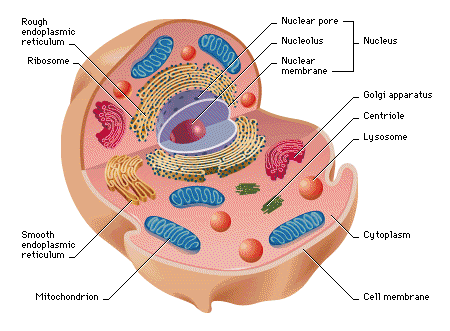|












.
| |
Animal
Cell
How
to make a animal cell model
Fly
through a 3D animal cell
Brief
description of a Animal cell

|
An
animal cell typically contains several types of membrane-bound organs, or organelles.
The nucleus directs activities of the cell and carries genetic information
from generation to generation. The mitochondria generate energy for the
cell. Proteins are manufactured by ribosomes, which are bound to the rough
endoplasmic reticulum or float free in the cytoplasm. The Golgi apparatus
modifies, packages, and distributes proteins while lysosomes store enzymes
for digesting food. The entire cell is wrapped in a lipid membrane that
selectively permits materials to pass in and out of the cytoplasm.
|
Provided by encarta.com please visit http://www.encarta.com/
Animal Cell Structure
Animal cells are typical of the eukaryotic cell, enclosed by a plasma
membrane and containing a membrane-bound nucleus and organelles. Unlike the
cells of the two other eukaryotic kingdoms, plants and fungi, animal cells don't
have a cell wall. This feature was lost in the distant past by the single-celled
organisms that gave rise to the kingdom Animalia.

The lack of a rigid cell wall allowed animals to develop a greater diversity
of cell types, tissues, and organs. Specialized cells that formed nerves and
muscles -- tissues impossible for plants to evolve -- gave these organisms
mobility. The ability to move about by the use of specialized muscle tissues is
the hallmark of the animal world. (Protozoans locomote, but by nonmuscular
means, i.e. cilia, flagella, pseudopodia.)
The animal kingdom is unique amongst eukaryotic organisms because animal
tissues are bound together by a triple helix of protein, called collagen. Plant
and fungal cells are bound together in tissues or aggregations by other
molecules, such as pectin. The fact that no other organisms utilize collagen in
this manner is one of the indications that all animals arose from a common
unicellular ancestor.
Animals are a large and incredibly diverse group of organisms. Making up
about three-quarters of the species on Earth, they run the gamut from sponges
and jellyfish to ants, whales, elephants, and -- of course -- human beings.
Being mobile has given animals the flexibility to adopt many different modes of
feeding, defense, and reproduction.
The earliest fossil evidence of animals dates from the Vendian Period (650 to
544 million years ago), with coelenterate-type creatures that left traces of
their soft bodies in shallow-water sediments. The first mass extinction ended
that period, but during the Cambrian Period which followed, an explosion of new
forms began the evolutionary radiation that produced most of the major groups,
or phyla, known today. Vertebrates (animals with backbones) are not known to
have occurred until the Ordovician Period (505 to 438 million years ago).
 |
Centrioles
- Centrioles are self-replicating organelles made up of nine bundles of
microtubules and are found only in animal cells. They appear to help in
organizing cell division, but aren't essential to the process.
 |
Cilia
and Flagella - For single-celled eukaryotes, cilia and flagella are
essential for the locomotion of individual organisms. In multicellular
organisms, cilia function to move fluid or materials past an immobile cell
as well as moving a cell or group of cells.
 |
Endoplasmic
Reticulum - The endoplasmic reticulum is a network of sacs that
manufactures, processes, and transports chemical compounds for use inside
and outside of the cell. It is connected to the double-layered nuclear
envelope, providing a connection between the nucleus and the cytoplasm.
 |
Golgi
Apparatus - The Golgi apparatus is the distribution and shipping
department for the cell's chemical products. It modifies proteins and fats
built in the endoplasmic reticulum and prepares them for export to the
outside of the cell.
 |
Lysosomes
- The main function of these microbodies is digestion. Lysosomes break down
cellular waste products and debris from outside the cell into simple
compounds, which are transferred to the cytoplasm as new cell-building
materials.
 |
Microfilaments
- Microfilaments are solid rods made of globular proteins called actin.
These filaments are primarily structural in function and are an important
component of the cytoskeleton.
 |
Microtubules
- These straight, hollow cylinders, composed of tubulin protein, are found
throughout the cytoplasm of all eukaryotic cells and perform a number of
functions.
 |
Mitochondria
- Mitochondria are oblong shaped organelles that are found in the cytoplasm
of every eukaryotic cell. In the animal cell, they are the main power
generators, converting oxygen and nutrients into energy.
 |
Nucleus
- The nucleus is a highly specialized organelle that serves as the
information and administrative center of the cell.
 |
Peroxisomes
- Microbodies are a diverse group of organelles that are found in the
cytoplasm, roughly spherical and bound by a single membrane. There are
several types of microbodies but peroxisomes are the most common.
 |
Plasma
Membrane - All living cells have a plasma membrane that encloses
their contents. In prokaryotes, the membrane is the inner layer of
protection surrounded by a rigid cell wall. Eukaryotic animal cells have
only the membrane to contain and protect their contents. These membranes
also regulate the passage of molecules in and out of the cells.
 |
Ribosomes
- All living cells contain ribosomes, tiny organelles composed of
approximately 60 percent RNA and 40 percent protein. In eukaryotes,
ribosomes are made of four strands of RNA. In prokaryotes, they consist of
three strands of RNA.
|
| | | | | | | | | | |
|
![]()
